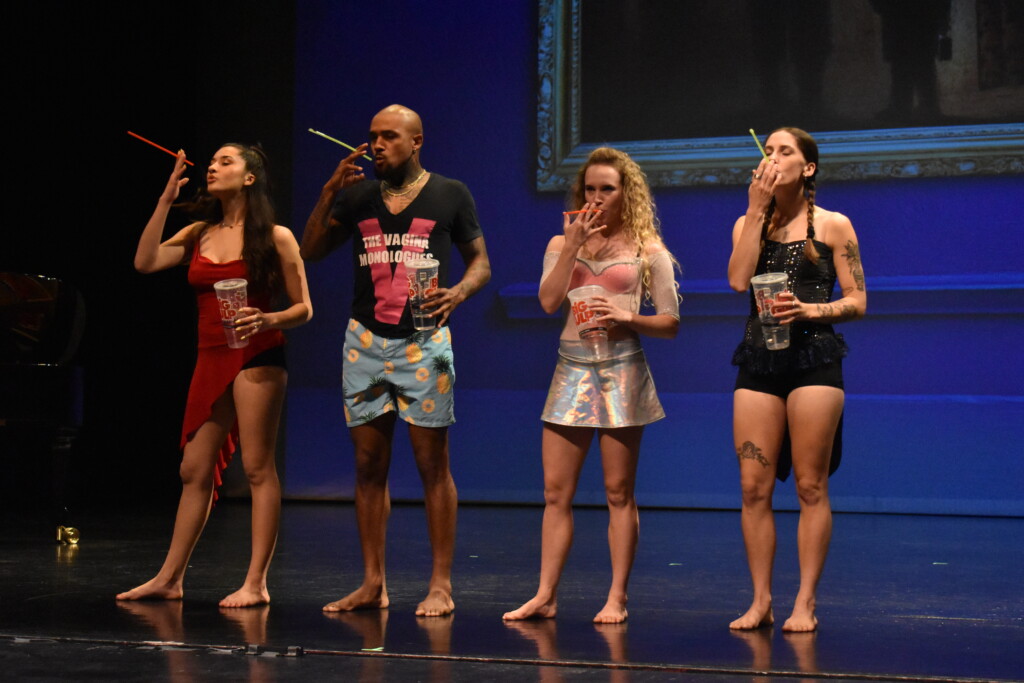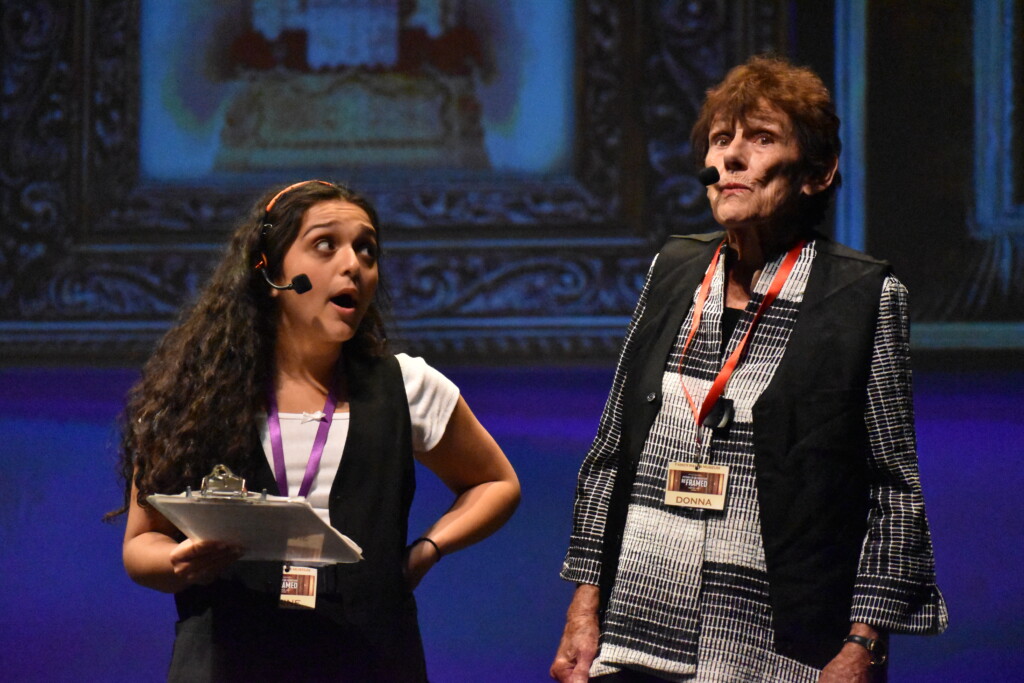As appealing as collaboration is, many arts organizations are more likely to make a bit of an awkward, even contentious mess of it. In some instances, performing arts organizations choose the safer route for collaborating, by setting a broadly articulated theme for everyone to contribute their distinct piece to the effort. But, if groups sincerely embrace the full meaning of collaboration, then the risks and efforts can pay out bushels upon bushels for the producers, performers and the audience.
For Pictures at an Exhibition: ReFramed, the Performing Arts Coalition of the Rose Wagner Center for Performing Arts passed the test of full collaboration with top honors, to the energetic roar of approval from a sold-out house at The Rose’s Jeanné Wagner Theatre. The companies featured were Gina Bachauer International Piano Foundation, Plan-B Theatre, PYGmalion Theatre Company, Repertory Dance Theatre (RDT), Ririe-Woodbury Dance Company and SB Dance.

Photo: Sharah Meservy.
After a bit of a tentative start, the show, directed by PYGmalion Theatre Company’s Fran Pruyn, shifted into the proper gear and went splendidly thereafter. The companies had agreed on setting their respective contributions upon a framework scripted by award-winning Utah playwright Melissa Leilani Larson, who incorporated input from everyone. The foundation for the script came from Modest Mussorgsky’s Pictures at an Exhibition, one of the best-known pieces from classical music. For a creative brief that emphasized full collaboration, it was an ideal selection to hit all the marks for theater, dance and music, with Mussorgsky’s piano score that pays homage to an otherwise forgotten Russian artist and architect Viktor Hartmann.
Larson set the premise in a small museum preparing for a major exhibition and an opening reception that would feature in part Hartmann’s paintings, the ones captured in Mussorgsky’s music It is a chaotic day, as museum staff scramble to fill in the missing spots with paintings by other artists (Kandinsky’s work really fits well with the music, incidentally). Meanwhile, a nervous new docent is trying to find her way on the first day and she is thankful that at least one docent is willing to help while the senior volunteer goes about her usual curmudgeonly ways. Along the way, Larson infuses just enough historical background about Hartmann and the provenance of the music without interrupting the rhythm and cadence of the action on stage.

Photo: Sharah Meservy.
The museum setting is created with projections of the gallery space, courtesy of Daniel Charon, Ririe-Woodbury’s artistic director. The cast of museum staff characters carried along the narrative effectively with plenty of humor, including Anne Decker, Tamara Howell, Corinne Penka, Niki Rahimi and Benjamin Young. Serhiy Salov, the silver medalist for the 2010 Bachauer International Artists competition, was not just a pianist but also an actor, a role that he took with gusto and natural flair. In addition to Mussorgsky’s music, he played other selections incorporated appropriately into the show, such as snippets from Schumann’s Scenes from Childhood piano suite, including the famous Träumerei, which provides the underscoring during a witty scene when museum patrons (performers from SB Dance) are lulled to sleep by the boring talk of a ‘decent docent.’ Likewise, another miniature classical warhorse, Schubert’s Moment Musicaux No. 3 in F minor, as well as Mozart’s La tartine beurée (Bread and Butter) fit nicely within the narrative action as set pieces. Salov also offered a shimmering rendition of Feux d’artifice (Fireworks), from the second book of Debussy’s famous Preludes for solo piano.
And, there were the three dance institutions — SB Dance, RDT and Ririe-Woodbury — who delivered knockout performances across the board. The highlight came in the finale, as Salov played the supreme audience pleaser from Mussorgsky’s suite The Great Gate of Kyiv, when the dancers from all three companies steadily assembled on stage to create a replica of the image in Hartmann’s painting. RDT’s Nicholas Cendese choreographed it, adding the dome and giant-sized soda cups (for the bells) to complete a convincing replica. Another sign of just how thoroughly the companies took up the spirit of this collaborative endeavor was the cross-mingling of dancers from RDT and Ririe-Woodbury for partnering in some of the choreography.

This was the 13th year for a Performing Arts Coalition show at The Rose and while there have been many memorable moments over the year, this particular edition seemed to hit with perfect pitch. By far, it also generated the most enthusiastic audience response this reviewer has seen for the annual show. Then again, all six companies have consistently been raising the heights on artistic innovation and excellence in recent seasons.
The 2024-25 season merits public attention. Coming up, Plan-B Theatre will launch its 12th Free Elementary School Tour (FEST) production, EllaMental by Dee-Dee Darby-Duffin, in September, including two free public performances. Its first season subscription production will be Full Color (Oct. 24-Nov. 10), featuring eight BIPOC actors in Utah who speak the truths of their eight BIPOC playwright counterparts. PYGmalion Theatre Company will open its season with Tender Hooks by Julie Jensen (Oct. 4-19), a Utah playwright whose works have been extensively produced nationally and internationally. Bachauer will open its concert series for the 2024-25 season with Anna Han (Sept. 27), an internationally known pianist in a program of music by Bach, Prokofiev and Rachmaninoff. RDT will open its season with a production of two major works by choreographer Noa Zuk (Oct. 4-6), with whom the company has had an artistic relationship for a decade, Ririe-Woodbury’s new season will open with Re-Play (Sept. 19-21) with a world premiere by Daniel Charon, a company premiere of Monica Bill Barnes’ Wish You Were Here and a reprise of 2022’s The Bunker by LajaMartin. SB Dance continues its performances of Tarotville, as part of its annual Curbside Theater program, which runs August through October.
